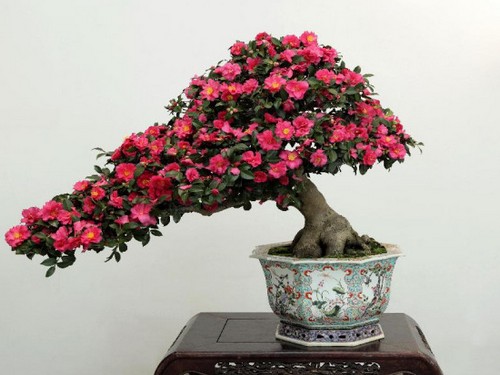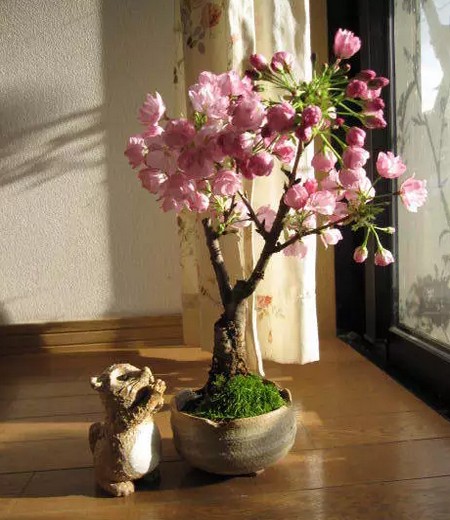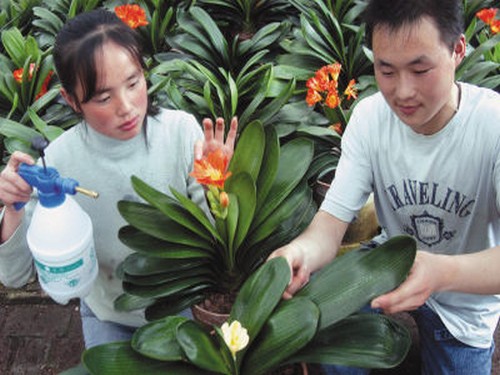Cultivation techniques of Camellia miniascape
Camellia likes warm and humid climate environment, avoid the sun, like half shade scattered light, but also tolerant shade. Camellia is a common shrub or small tree. It likes warm climate, suitable temperature for growth is 18~25℃, initial flower temperature is 2℃. A little cold, general varieties of tolerance-10℃ low temperature heat resistance, but more than 36℃ growth is inhibited. Like air humidity, bogey dry, suitable in the annual precipitation of more than 1200mm of growth. Like fertile, loose slightly acidic soil, PH 5.5~6.5 is best. There are two shoots sprouting in a year, the first is spring shoots, and summer shoots begin to sprout from March to April and July to September. The flowering period is long, most varieties are 1~2 months, and the flowering period of a single flower is generally 7~15 days. The flowers bloom from February to March.

1, suitable for the environment
Camellia likes to grow in an environment where the air flows moderately, and likes the breeze blowing most. It likes the water vapor brought by the southeast wind, but it is afraid of the northwest wind and strong wind, which will make the water evaporate too fast. The balance between supply and demand of Camellia is out of balance, and the leaves are also easy to damage, resulting in the phenomenon of bud and flower falling. Winter camellia should be placed in the wind and sunny environment maintenance, and there is a certain temperature and humidity. In spring and autumn, the flowerpot should be moved to the balcony to make it ventilated and transparent, and shaken by the breeze. This not only helps the plant grow well, but also helps the flower bud differentiation, flower bud growth and development, and can also reduce the occurrence of diseases and insect pests. Through many years of practice shows that moderate ventilation, suitable lighting, can play a role in preventing diseases and insect pests.
2. Applicable soil
Soil is the growth base of potted camellia, because camellia roots depend on soil for growth and development, and the water and nutrients needed for camellia life activities are mainly absorbed from soil. Camellia likes acid, high humus content, loose ventilation of the mountain red (yellow) loam, pH value between 5 and 6.5, can not use alkaline soil or sticky heavy soil for potted Camellia substrate. Soil preparation: mountain soil (mature red loam soil for planting crops) 50%, sawdust or edible mushroom residue 40%, cake fertilizer powder or livestock manure and phosphate fertilizer powder 10%, mix the three evenly, water properly bagged for ripening, more than 20 days in summer and autumn, more than 30 days in spring and winter, this soil is not only loose and ventilated, but also can keep fertilizer and water, suitable for the growth and development of camellia.
3. Moderate light
Camellia needs appropriate light, but also afraid of direct heat and the sun. In spring and late autumn, camellia flowers should be moved to the balcony or ground where there is much light, and receive all-day light to promote plant growth and development, promote flower bud differentiation and bud health. In summer, the sun is the strongest, so the flowerpot should be moved to a sunny and well-ventilated environment for maintenance. It can also be moved to the north balcony or the south balcony for cultivation. 75% sunshade net can also be used to cover the plants from 9 a.m. to 5 p.m. to avoid direct sunlight, causing leaf injury or small plant withering. If conditions permit, the camellia should be moved to the sun shed for safe summer.
4, suitable temperature
Temperature is an important condition for camellia physiological activities. Camellia likes warm, the most suitable temperature for growth is 18℃ to 25℃, relative humidity 60% to 65%. Camellia growth, spring shoots generally sprout in late March, April began to sprout, mid-late May to form terminal buds, stop growing, gradually differentiated leaf buds or flower buds, from flower bud formation until flowering to 180 days to 240 days. Summer shoots sprout in late July and stop growing in early September. Although camellia is resistant to low temperature, when cold wave invades, the temperature drops suddenly below 0℃ or encounters dry northwest wind, it will cause tender shoots to freeze, buds will wither by freezing damage, for this reason, the flowerpot will be moved to the north to the south for maintenance, so that it can safely overwinter.
5, suitable humidity
Camellia leaves, leaf area, transpiration fast. Camellias like humid climates and wet soil. Therefore, it is necessary to supplement the water content of potted camellia, watering once a day in the spring and autumn growing season, watering once a day in the morning and evening in summer, especially in the "dog days", watering or spraying water once or twice to the ground and periphery of the flowerpot if the ground is dry, maintaining a certain air humidity, and the plant will grow luxuriantly. At the same time, note that due to watering, and most families are watering tap water, the soil of the flowerpot will be alkalized over time. For this reason, when watering, 0.5% to 1% ferrous sulfate water can be added every month, and 5% to 8% edible acid vinegar can also be used to spray the leaves. Camellia likes wet soil, but afraid of water in the pot, in rainy days if water in the pot, must be removed in time, so as not to soak the roots in the water suffocated, rotten.
6. Appropriate amount of nutrients
Camellia is a fertile flower, because the tree is strong, more leaves, flowering is longer, so the amount of fertilizer is also more. In the process of fertilization, apply enough liquid fertilizer, combine with changing pots to apply enough long-acting fertilizer, according to the size of flower pots, apply 3 grams to 80 grams of decomposed cake fertilizer powder or dried chicken and duck dung per pot, put it under the pot and mix well with the subsoil. According to the plant growth period, increase the application of organic fertilizer. Except for the coldest and hottest time in winter and summer, apply decomposed dry cake water once or twice a month. The fertilization method is as follows: peel the soil at the edge of the basin for about 2 minutes, apply liquid fertilizer into the ditch and cover it with soil to avoid peculiar smell. You can also apply decomposed cake fertilizer powder to the edge of the pot and mix well with the pot soil, so that flowers can slowly absorb it. City flower friends can go to the flower market to buy special fertilizer for flowers, which is both sanitary and safe. In order to make camellia peanut grow better, in the vigorous period of camellia peanut, it is necessary to apply fertilizer outside the root once or twice a month, spraying leaves with 0.2% to 0.3% potassium dihydrogen phosphate and 1% to 2% plant auxin. Principles of fertilization: light should not be heavy, light should not be thick, less should not be more, must adhere to the method of thin fertilizer and frequent application, especially do not apply raw fertilizer.
Time: 2019-05-25 Click:
- Prev

Cultivation techniques of Cherry Blossom Bonsai
The cherry blossom is a symbol of the Japanese nation, which has an irreplaceable position in the eyes of the Japanese, representing their spirit and aesthetics, at all costs for the brilliance of the moment. The Japanese call cherry appreciation a flower meeting, which has been called a folk custom. Cherry blossoms can be potted. Cherry blossoms are suitable to be planted in most areas of China.
- Next

Cultivation techniques of bonsai of Cymbidium
Many customers actually like to raise some green plants at home, improve indoor air quality and beautify the indoor environment, but many of them are distressed because they do not know the correct maintenance methods. Here are some techniques for bonsai cultivation. Reproduction: mainly use sowing method to propagate Magnolia.
Related
- Fuxing push coffee new agricultural production and marketing class: lack of small-scale processing plants
- Jujube rice field leisure farm deep ploughing Yilan for five years to create a space for organic food and play
- Nongyu Farm-A trial of organic papaya for brave women with advanced technology
- Four points for attention in the prevention and control of diseases and insect pests of edible fungi
- How to add nutrient solution to Edible Fungi
- Is there any good way to control edible fungus mites?
- Open Inoculation Technology of Edible Fungi
- Is there any clever way to use fertilizer for edible fungus in winter?
- What agents are used to kill the pathogens of edible fungi in the mushroom shed?
- Rapid drying of Edible Fungi

